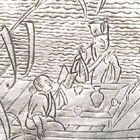J.J. Lally & Co., Oriental Art / New York City, New York
MenuPast Exhibition
Silver and Gold in Ancient China
March 16 – April 14, 2012
24.
A CHASED SILVER ‘RED CLIFF’ PICTORIAL DISH
Song Dynasty, A.D. 13th Century
decorated with a scene from the Former Red Cliff Ode by Su Shi (1037-1101), finely engraved in painterly baimiao style showing the poet in court robes with two companions relaxing in a boat drifting on tranquil water, with a winepot and cups on the table in front of them, one figure playing the flute and the other holding an open book, beside rocky banks with grasses and tall reeds, a willow and a cassia tree, and with a cascade spilling down from high cliffs at the far shore, the sky with a pair of birds flying to the left towards a constellation of seven stars drawn as circles joined by thin lines to form the “Big Dipper” seen through drifting clouds surrounding a full moon engraved with the legendary yu tu dao yao (玉兔搗藥) scene of the Moon Rabbit under the cassia tree, pounding a pestle in a mortar to mix his magic elixir of immortality, the shallow plain sides of octafoil bracket-lobed outline rising to a barbed everted rim.
Diameter 10 3⁄8 inches (26.5 cm)
Published Itakura, ‘Red Cliff in Imagery—Song Dynasty Painting and Artifact,’ in Sōgen no bi: denrai no shikki o chūshin ni (The Colors and Forms of Song and Yuan China – Featuring Lacquerwares, Ceramics and Metalwares), by Nishida and Tahira (eds.), Nezu Institute of Fine Arts, Tokyo, 2004, p. 44, fig. 3
The Chibi fu (Red Cliff Odes) are two prose poems written by Su Shi (1037-1101) as first person narratives of philosophical conversations with friends while drifting past the historic Red Cliff on the banks of the Yangzi River. The poet describes the setting and the actions of his companions in the boating party and records his thoughts on the brevity of life and the futile striving of ambitious men. The picture on this silver dish closely follows the poet’s description, and the three Chinese characters inscribed on the book held by a figure in the boat: qian chibi (前赤壁, Former Red Cliff), give the popular title of the first ode.
Su Shi was one of the most influential scholar-officials of the Northern Song. He was famous in his lifetime as a statesman, artist, calligrapher, writer, and poet. Su Shi died in 1101, but his reputation and fame continued to grow after his death as shrines and memorials were erected in his honor and connoisseurs collected his poems and calligraphy. Scenes from his life and literature, especially the scene of the Red Cliff Odes, which was his most popular work, were painted soon after his death. A ‘Red Cliff’ painting by the Southern Song artist Li Song (1190-1225) in the Nelson-Atkins Museum of Art, with a closely related composition showing Su Shi and companions in a small boat on the moonlit Yangzi River, is illustrated in Eight Dynasties of Chinese Painting: the Collections of the Nelson Gallery-Atkins Museum, Kansas City, and the Cleveland Museum of Art, Cleveland, 1980, p. 54, no. 37. An anonymous Southern Song painting of the same subject, in the National Palace Museum, Taipei, is illustrated by Lee and Lin (eds.), Juan qi qian dui xue: chi bi wenwu tezhan (A Thousand Churning Waves: The Legendary Red Cliff Heritage), Taipei, 2009, pp. 82-83, no. 11-3, described as “a typical depiction of Chibi (Red Cliff) scene during the Southern Song.”
The style of depiction of the trees, rocks and waves on the present dish compares very well to the style of another ‘Red Cliff’ painting by the artist Qiao Zhongchang (active early 12th century), in the collection of the Nelson-Atkins Museum of Art, illustrated by Lin (ed.), Da guan: Bei Song shuhua tezhan (Grand View: Special Exhibition of Northern Sung Painting and Calligraphy), Taipei, National Palace Museum, 2006, pp. 164-169. Compare also the ‘Red Cliff’ painting attributed to Wu Yuanzhi (active late 12th century), depicting a small boat sailing by a steep mountain cliff, in the National Palace Museum, Taipei, illustrated in the catalogue of the same 2009 special exhibition, op. cit., pp. 74-75, no. 11-2.
A Ding ware white porcelain dish with shallow lobed sides and barbed rim very similar in form to the present silver dish is illustrated by Rawson in The British Museum Book of Chinese Art, London, 1992, p. 219, no. 160, attributed to the 12th century. Rawson describes the form of the dish as “copied from silver ware of the same period,” and suggests that the central scene “Xiniu Gazing at the Moon” may have been reproduced from a contemporary painting.
宋 「前赤壁賦 」山水人物銀盤 徑 26.5 厘米
